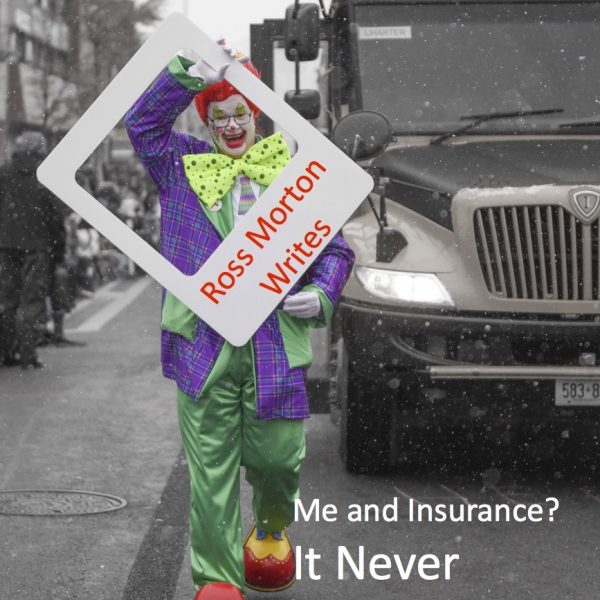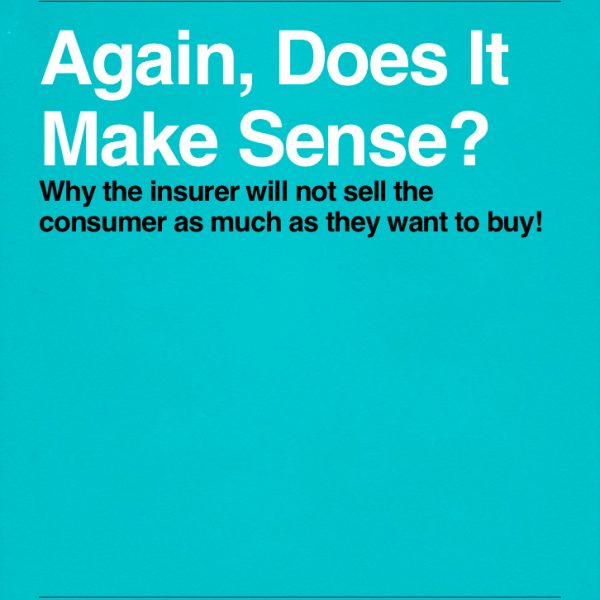Reinsurance looked like it was emerging as a significant part of the insurance landscape in Canada and for that matter in North America. Everyone wanted to be either a reinsurer or retrocessionaire. It looked like fun and a way to get relatively low cost premium income. There was no new expansion after 1990 and the best reisnurer had been bought by Swiss Re in 1988 so it was gone already. Look at the list of active reinsurers in 2003 and the volumes of risk they were paid to accept. The number is beyond the most optimistic of visionaries. Cheap prices by reinsurers and low risk tolerance by insurers plus the advent of the slogan “use of capital” all fueled the growth of reinsurers who then found themselves with almost too much business. Consolidation was fast and clean. Zap and you are down to less than half the active reinsurers. Even ERC who was a dynamo in Canada for 5 years ended its run for the gold in 2003 (officially in 2004).
I know of no person in the reinsurance business who would l have predicted in 1990 that such an astronomical percentage of life risk would be concentrated in so few companies by 2003. I now know looking back I should have had a bonus based on production with no cap!
Steve the editor again wanted to give his readers insight into reinsurance and how much the reinsurer played in the insurance sandbox. Today Steve and MO would probably have a monthly graph of reinsurance production and accompanying S&P ratings of the survivors.
Time to write the history of reinsurance from 1990 to 2005 (publishing in 2005 is closer to my timeline than 2004 for a variety of reasons). Now to find that publisher and first an editor. Steve how’s your time?
Ross
2004-04-14
Marketing Options
December 1991
I cannot fathom why such small amounts of reinsurance on so few policies can raise so many questions from some agents and home office employees. Believe me; reinsurance should never be intimidating or enigmatic. One big advantage in Canada is that eh players are few. So few, in fact, that I hope to introduce them all to you in this single article today.
Every year the Munich Re office in Atlanta, Georgia, compiles new business statistics from reinsurers and retrocessionaires throughout North America. In the U.S.A., the list for 1990 shows 26 active reinsurers chasing a ceding company’s excess insurance (over the individual company’s retention). That same market place produced $20 billion less reinsurance sums assured in 1990 than in 1988, ending at $152 billion. There were only 5 fewer active reinsurers in 1991 and the inactive dropouts could be viewed as casualties of a very aggressive market that could not continue to sustain so many corporate entities.
The Canadian numbers pale in comparison but who north of the border ever found comparison flattering? Please tolerate the fact that the Canadian industry numbers will be in U.S. Dollars and, for the lack of a calculator, this poor author is taking the easy way-out. In 1988 the Canuck insurance industry sent nearly $13 billion of new sums assured to reinsurers and the number tumbled in 1990 to just over $10 billion (out of $92 billion for the whole industry). By whatever measure the reinsurance industry in both countries took a beating in market potential. Fortunately it is still ticking and cooperative as ever in trying to help life companies of all sizes manage the mortality risk. (It does other things but I’m a uni-dimensional visionary on a roll)
There are many and sundry excuses for the demise of the market growth but suffice to say the time had come. Cheap, cheaper and cheapest term had taken its toll on in-force blocks. Smoker and non-smoker discrimination extended the feeding frenzy for new products at even lower pricing, culminating in sums assured escalating at a pace that outstripped retention. Along comes the ‘A’ word and fear halts some retention changes. Now we top the early nifty nineties nirvana with financial scrutiny of direct writers until it almost becomes wiser to reduce retention and spread the volatility of risk.
Enough pontification on the unsolvable and back to the hard facts of numbers, the root of our rewarding enterprises. The Canadian reinsurance numbers are split among 11 active reinsurers and pseudo-reinsurers (those with split or multiple functional personas operating as reinsurer, retrocessionaires and/or direct writers.) In reality, the number of players hasn’t altered significantly over the years but it has in actual key players. Many (at lease two) key reinsurers have left the active market and there exists a strong groundswell of opinion they were legends in their own time but I would not want to solicit a quorum on that issue.
Fig. 4 reflects the composition of the Canadian reinsurance world and highlights the diversity of reinsurers who are still active according to the Munich Re study. During the five year study, three reinsurers have shared the honour of being the host with the most new business and, if the study were to be extended backward, they remain the “Big Three” – the loving nickname created over a decade ago by a significant, yet perennial, “Number Four”.
In alphabetical order the Big Three are the Canadian Re, the Mercantile & General Re an the Munich Re. These three companies are all related to large head offices or parents in Europe who have zillions of years of history behind them. The parentage is obvious for two of them and more obtuse for the third. Reversing the order to protect my income, as a retrocessionaire should, the Munich Re is part of the world’s largest reinsurer out of Munich Germany. The M&G (an affectionate acronym coined and perpetuated by the industry) is of English/Scottish lineage with a well known owner in the international sphere – Prudential of England. The third player comes from the clocklike precision of Swiss workmanship under the more global nomenclature of Swiss Re, a leading reinsurer in the markets of the world.
The habitual holders of positions four through eight inclusive are there both by design or the sheer magnitude of the final step to turn the Big Three into the “Big Four” (or five or six). There one must stop or all you have is a cluster of the “Nondescript Eight”. With due respect to the future, I remain fixed on the alphabetic listing of General American, Life Re, Lincoln National, National Re, and St. Lawrence Re. This is a diverse group of companies that refuse to fit a homogeneous description and each has distinct roles to play in prodding and, in time, shaping the reinsurance dimensions in Canada. St. Lawrence grew slowly at first with modest beginnings soon overshadowed buy aggressive and novel marketing innovations that catapulted it into the limelight. Its roots are in Montreal where it retains its license base and corporate head office. Likewise, National Re has its origins in Quebec, yet has played an influential role in both facultative and automatic reinsurance from sea to sea. Both of the foregoing reinsurers are talented users of retrocessionaires throughout the world, spreading the mortality and financial risk.
Lincoln National is one of the earliest licensed reinsurers in the Canadian market. It is part and parcel of the large U.S. Reinsurer out of Fort Wayne, Indiana. The definitive nature of its marketing efforts and positioning has remained ever constant. Life Re (formerly General Re) has had a sporadic involvement in the Canadian market seeking particular market niches that reflects its particular strategy. Their head office is in New York. General American, operating out of St. Louis, Missouri, is both a reinsurer and a retrocessionaire in the Canadian market. In the U.S., it is the second largest writer of new reinsurance volumes. In both its Canadian roles it has been extremely influential in the setting of pricing standards.
The remaining contingent of also–rans is best described as peripheral players who neither set market price nor support the aggressive nuances of the leaders and aspiring leaders of reinsurance.
As the reader’s eye moves to the chart of retrocessionaires (Fig.5), it becomes noticeable that the names become better known while the new sums assured drop quite considerably. Ignoring one mother of all reinsurance deals in 1988, the early noted pattern of the reinsurers is replicated in the retrocessionaires – the market size has dwindled. The real deal makers in this group number only five with volumes dancing through the years without pattern. Three large direct writing companies play an exclusive role as retrocessionaires, while General American actively and directly supports the niche reinsurers. Sun is a big company with a definite professional approach to retro business that some say it learnt from Manulife. In reality, the two were active as reinsurers in old traditional reciprocity deals for a hundred years. The sheer size of these fortresses of financial integrity (it’s annual review time) make them both natural retrocessionaires. Manulife was the first truly active solicitor of retro business on a whole sale basis and leapt to the forefront in the 1980s. Equitable has been somewhat more modest in its overtures to the Canadian reinsurers and, at times, people mistakenly think they are the Canadian Equitable to Kitchener/Waterloo when in reality they are the Equitable Society of America.
Other players come and go in this arena of big cases which is a function of capacity wishes that fluctuate wildly. There are not that many jumbo cases to go around every year and reinsurers are increasingly looking at the financial credibility of the retrocessionaires to ensure the long term support for behemoth policies that require retro.
All the players are front and centre with nothing to hide. Each, I am sure, would give details of their operations should you make a polite request. They are an innovative and gregarious group who only bear close control when food and drink entices unbridled articulation. I am not saying that all of their stories are candidates for a Pulitzer Prize but each is an interesting piece of literature.





